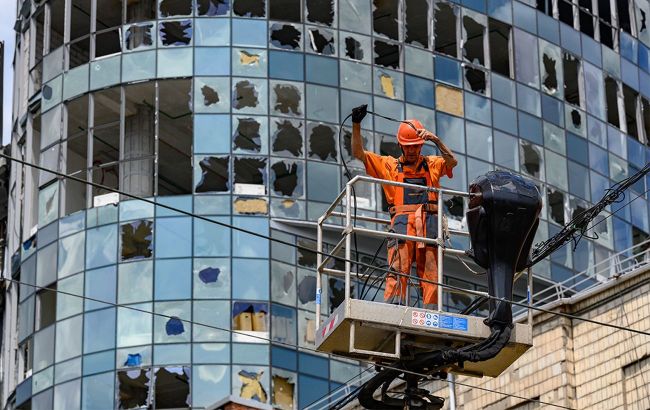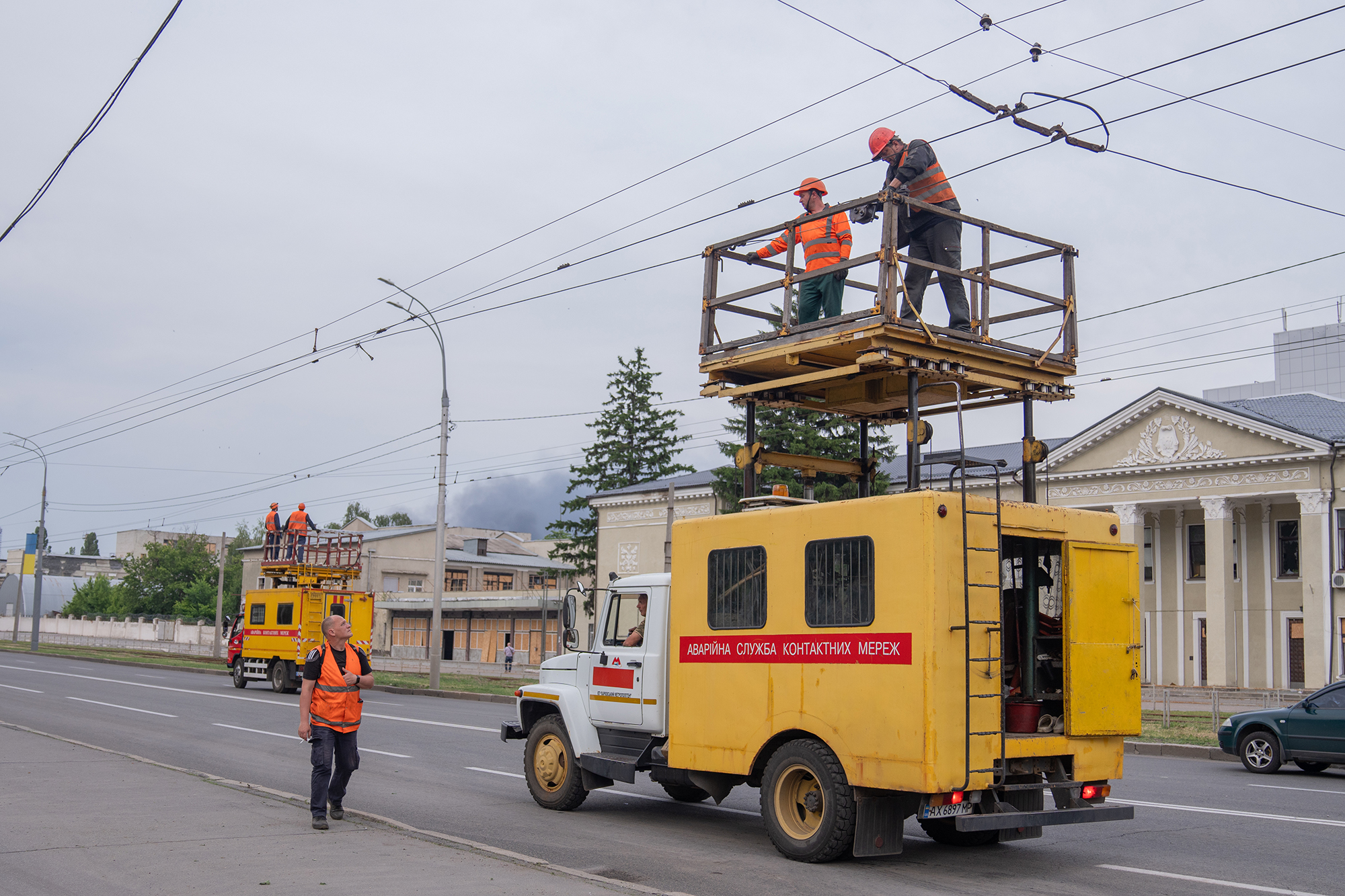New targets, new tactics: How Russia is hitting Ukraine's energy differently this time
 Russia has intensified its attacks on Ukraine (photo: Getty Images)
Russia has intensified its attacks on Ukraine (photo: Getty Images)
Russia has changed its tactics of attacking energy targets in Ukraine. Read below whether the air defense is ready for enemy strikes on the eve of winter, and how the protection of facilities can be improved.
Two months ago, Russia began a new wave of attacks on Ukrainian energy facilities. In early August, the oil depot of the Azerbaijani oil company SOCAR in the Odesa region came under attack. Then the attacks continued, targeting energy facilities in different regions of the country.
On September 8, the Trypilska thermal power plant was hit, causing power outages in nearby settlements and parts of Kyiv. In early October, gas production facilities in the Kharkiv and Poltava regions came under the most powerful combined attack. “This is the most massive attack on our gas production infrastructure since the beginning of the full-scale war,” said the head of Naftogaz of Ukraine, Sergii Koretskyi.
Considering that the largest attack on Ukraine’s gas production took place in February 2025, when losses amounted to about 40% of daily output, the new attack had even more serious consequences.
In recent days, strikes on energy infrastructure in the regions have intensified. Due to damage to gas and power networks, tens of thousands of consumers were left without gas and electricity. Problems occurred in the Zaporizhzhia, Kherson, Vinnytsia, Kharkiv, and even Lviv and Ivano-Frankivsk regions.
Most of the damage has been repaired, and services have already been restored to consumers. As of the evening of October 6, 3,500 consumers in the Kharkiv region remained without electricity.
The situation remains quite difficult in the Sumy and Chernihiv regions. According to Deputy Minister of Energy Mykola Kolesnyk, these regions are using emergency service supply schemes and connections to alternative power sources.
In the Chernihiv region, rolling blackout schedules are being applied. “The schedules are used so that repair work can be carried out in parallel and electricity supplied to all consumers,” Kolesnyk noted.
Russia has changed its tactics
The increase in strikes on facilities in Ukraine, including energy infrastructure, can be explained by Russia changing its attack tactics. As Anatolii Khrapchynskyi, deputy general director of a company producing electronic warfare equipment, told RBC-Ukraine, the attacks are now not only combined but also denser.
“The effectiveness of Russian strikes is becoming more noticeable. The enemy not only combines strike means but also increases their density — now more missiles and drones fly toward targets simultaneously, from different directions, focusing on several key axes. We should also not forget about the constant attacks on the energy infrastructure in the Sumy and Chernihiv regions,” he said.
Having intelligence data on air defense systems located near potential targets and understanding their reloading and preparation times, the Russians calculate the right moment to strike so that the number of weapons used significantly exceeds the capabilities of air defense systems.
The Russians actively use decoy drones to distract air defense forces, deploying Shaheds and missiles whose flight paths necessarily pass over populated areas. “This complicates the interception process and may have incidental consequences during interception,” Khrapchynskyi noted.

Repairing power lines in Kharkiv (photo: Getty Images)
The Russians have changed not only their tactics but also their choice of targets. If earlier they attacked large transmission system facilities (operated by Ukrenergo) and generation plants, now the attacks mainly target distribution system facilities — regional power companies and other operators supplying electricity to end consumers.
According to Hennadii Riabtsev, director of the Psychea Center, this change in target selection tactics is very dangerous because all engineering and technical protection programs were previously implemented centrally and covered primarily the largest energy companies — Ukrenergo, Naftogaz, and others.
The safety of supply companies was the responsibility of local authorities, which, due to a lack of funds, have not ensured the necessary level of protection everywhere. Probably, having more detailed information about the regions, the Russians are building their tactics accordingly, Riabtsev believes.
“It’s possible that the analysis of this information led to the shift in emphasis toward striking local operator equipment. We can see how effective the strikes on Shostka and Chernihiv were. Therefore, it is now necessary to analyze the causes of such consequences as quickly as possible,” Riabtsev said in a comment to RBC-Ukraine.
Active defense of facilities needs strengthening
Riabtsev also believes that, in addition to engineering and technical protection, active protection through air defense means must be strengthened. The least protected today, he noted, is the northern direction.
“If we look at where most drones are flying from and where they most often reach their targets, it’s the Chernihiv region. This indicates problems with both active and engineering-technical defense systems in this direction,” the expert said.
Anatolii Khrapchynskyi also spoke about the need to strengthen air defense protection. “We need to talk about increasing the elements of air defense, specifically in the counteraction system, and creating active defense systems near strategic facilities. Of the other protection systems (engineering and technical), the only effective one is underground placement of the facility,” Khrapchynskyi said.
Member of the parliamentary energy committee Serhii Nahorniak suggested increasing the use of helicopters to more effectively shoot down drones. Ukraine already uses them for this purpose. According to Commander-in-Chief of the Armed Forces Oleksandr Syrskyi, helicopters demonstrate high effectiveness and, depending on weather conditions, sometimes shoot down up to 40% of drones in their areas.
Strengthening the protection of strategic facilities is extremely important, as the Russians will likely continue bombarding Ukraine’s energy infrastructure. A compromise option, such as a reduction in the intensity of strikes by both sides, as happened last year, should not be expected this time.
Where Russia may strike next
It is difficult to predict what the Russians’ next targets will be. Riabtsev does not rule out that they could include gas import capacities, gas storage facilities, or electricity generation and Ukrenergo facilities.
According to deputy head of the parliamentary energy committee Oleksii Kucherenko, the installation of second-level protective structures — concrete constructions — has been completed at only half of Ukrenergo’s facilities.
Ukrenergo confirmed that second-level protection has been installed for every second transformer. “The rest will be protected in the first half of 2026 (with the second level),” Ukrenergo CEO Vitalii Zaichenko told RBC-Ukraine.
Ukrenergo, he noted, continues to install anti-drone protection at key transmission system facilities. Second-level protective structures significantly reduce the time required for emergency repair work after enemy attacks. The protective structures already built have proven effective after direct drone strikes, and at some facilities, after several hits in a row.
Each substation usually has two transformers. To install protection, they must be disconnected. “Disconnecting a significant amount of equipment at once, around which the protection needs to be built, would mean long power outages for consumers across large territories. Therefore, the construction process was divided into two stages,” Zaichenko explained.
The first included key substations to preserve the integrity of the power system’s operation during electricity transmission from west to east and from south to north. “As of today, the transformers in the first phase are already protected; the second is planned to be completed in the first half of 2026,” Vitalii Zaichenko noted.
The need for additional gas imports
The issue of protecting energy facilities was discussed on October 6 at the Supreme Commander-in-Chief’s Staff meeting. According to Volodymyr Zelenskyy, there were reports on the deployment of additional air defense capabilities.
“Additional resources are still needed so that there is an adequate response to every problem,” the President of Ukraine said.
Deputy Minister of Energy Mykola Kolesnyk said that negotiations are underway with international partners to assist in reducing the risks of the heating season.
“We have an understanding of additional capacities to cover demand and measures needed to stabilize the operation of the gas transmission system as a whole,” Kolesnyk said on Ukrainian TV.
In a comment to RBC-Ukraine, he clarified that this refers to funds for importing additional gas volumes that Ukraine seeks to attract from partners.
According to Energy Minister Svitlana Hrynchuk, the discussion concerns an additional import of about 1.5 billion cubic meters of gas. Negotiations are ongoing with the EBRD, the European Commission, and partner countries to raise funds for these purposes.
According to unofficial government forecasts previously obtained by RBC-Ukraine, under a negative scenario, Ukraine may need an additional 2–2.4 billion cubic meters of gas, in addition to the 13.2 billion planned to be accumulated in storage by mid-October.
As of October 6, the plan is almost fulfilled — 12.83 billion cubic meters have been accumulated. However, in recent days, according to open data, amid colder weather and infrastructure damage, the rate of gas accumulation has decreased from 38 million (as of October 1) to 17 million cubic meters per day (as of October 6).
But the situation with the attacks is difficult to predict. Zelenskyy himself confirmed this, suggesting that Russia will do everything to prevent Ukraine from producing gas. There are risks of strikes on other industry facilities as well, while protecting absolutely everything will be quite difficult.

